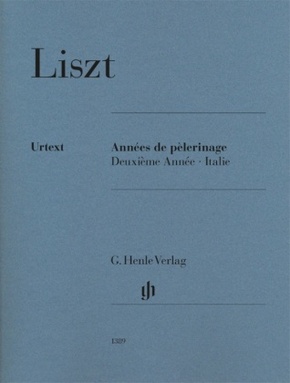Franz Liszt - Années de pèlerinage, Deuxième Année - Italie - Besetzung: Klavier zu zwei Händen
| Verlag | Henle |
| Auflage | 2022 |
| Seiten | 71 |
| Format | 22,5 x 0,8 x 31,2 cm |
| Gewicht | 350 g |
| Reihe | G. Henle Urtext-Ausgabe |
| ISBN-13 | 9790201813899 |
| Bestell-Nr | 95584447BA |
Entstehung und Veröffentlichung der ersten beiden Bände von Liszts "Pilgerjahren" sind eng miteinander verbunden. Nur ein knappes Jahr nach der Rückkehr aus der Schweiz brachen Liszt und seine Lebensgefährtin Marie d'Agoult im August 1837 zu einer mehr als zweijährigen Italienreise auf. Hatte der Komponist im "Schweiz"-Band vor allem Natur, Landschaft und Geschichte des Landes musikalisch umgesetzt, so widmet sich der "Italien"-Teil den Eindrücken aus Dichtung (Petrarca, Dante) und bildender Kunst (Raffael, Michelangelo). Die insgesamt sieben Stücke, deren Höhepunkt am Ende die sogenannte "Dante"-Sonate bildet und die zwischen 1838 und 1849 entstanden sind, wurden bis zur Publikation 1858 aber teilweise noch mehrfach umgearbeitet. Das drei Jahre später als Ergänzung erschienene Heft "Venezia e Napoli" ist separat als HN 985 erhältlich. Vorliegende Revision berücksichtigt erstmals auch eine handschriftliche Kopie der Nr. 2 mit Korrekturen von Liszt ("Stichvorlage"). Für den neuen F ingersatz konnte der Schweizer Pianist Francesco Piemontesi gewonnen werden.
Inhaltsverzeichnis:
Sposalizio Il Penseroso Canzonetta del Salvator Rosa Sonetto 47 del Petrarca Sonetto 104 del Petrarca Sonetto 123 del Petrarca Après une Lecture du Dante - Fantasia quasi Sonata
The composition and publication of the first two volumes of Liszt's "Années de pèlerinage" are closely interlinked. Barely a year after returning from Switzerland, Liszt and his companion Marie d'Agoult set off in August 1837 on a trip to Italy which was to last over two years. In the "Switzerland" volume the composer portrayed first and foremost the nature, landscape and history of the country in his music, whereas the "Italy" part is devoted to impressions from literature (Petrarch, Dante) and the visual arts (Raffael, Michelangelo). The total of seven pieces, the high point of which is the "Dante" Sonata at the end, were composed between 1838 and 1849, but parts were reworked several times before their publication in 1858. The "Venezia e Napoli" volume, published three years later as a supplement, is available separately as HN 985. In this revised edition, a manuscript copy of no. 2 with corrections by Liszt (the engraver's copy) has also been evaluated for the first time. The new fingering is by Swiss pianist Francesco Piemontesi.

